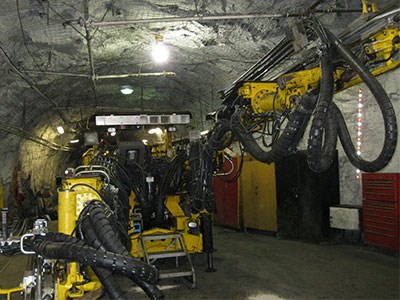From a small operation that began in the basement of their home, Rod and Clara Steele are now in the process of commercializing a product that could transform the tunnel-drilling process in underground mining.
Through their company, TesMan, which is a tenant at the Northern Centre for Advanced Technology (NORCAT) in Sudbury, the Steeles are installing motion-capture software onto jumbo drills underground to make drilling more precise, increasing efficiency and reducing the development costs of tunneling by up to 30 per cent.
A series of small, low-resolution cameras collect data and feed it back to the drill operator, who uses the information to determine where to drill. Data is processed through Mac Mini computers, so that everything can fit onto the equipment without it being intrusive to its operation, Rod said.
“Motion capture’s not new—you can go and get it in the gaming industry or surveillance industry or movie industry,” he explained. “But essentially what you’re looking at is very high DPI resolution cameras, lots of them, in very fixed positions, set up with surveillance and a lot of processing power in the background to process the size of images as fast as you need to.”
Cameras mounted on the drill look for light targets on the booms and translate the data into angle indicators, which appear on a screen before the drill operator. Data can also be used to create a 3D map of the tunnel. Providing the operators with more information allows them to do more precise drilling, which results in savings for the client and increases safety for the bolter, Rod said.
Clara brings to the team her experience in safety and finance from northern Manitoba, while Rod has worked primarily in operations and maintenance around the world. The two began working on the motion-capture concept in 2003, but only began to focus on it in earnest in 2008 after they began testing it at NORCAT’s Fecunis Mine.
They simultaneously offer consulting services on hard-to-solve mining conundrums, like the uranium mining concept they developed at Cigar Lake in Saskatchewan for Cameco, which allowed the company to seal off the tunnels and avoid flooding.
TesMan holds the worldwide patent for the motion-capture technology, which Rod said isn’t being used anywhere in the world in a development tunneling operation.
Computerized jumbo drills currently on the market are expensive and very specialized, he said. But the systems manufactured by TesMan can be adapted to any equipment, and they require little maintenance by the company.
The system sends data out from the unit, telling the client when maintenance is required. Other than changing the occasional burned out lightbulb, the miner has to do very little.
“The mine has complete control of the system, so it doesn’t require specialists to come in,” Rod said. “They can look after the entire package themselves, and you get the data that you would get off a computerized jumbo.”
After two years of testing at KGHM International’s McCreedy West Mine in Sudbury, the Steeles are now ready to move to commercialization. Clara said connecting with a reputable company has given them a huge opportunity to move to the next stage.
“It’s really hard to get new technologies into the mine,” Clara said. “It’s really hard to get your end user to buy into new ways of doing things, and so having McCreedy as our lab allowed us to troubleshoot and get over the hurdles of engaging the end user, because if you have the end user, which is the driller, engaged to use the product, then the rest falls into place.”
As it works to commercialize its motion-capture technology, TesMan will focus on local markets, but eventually wants to branch out into other metals, such as gold, and will move into Timmins by the end of the year. By the fall, the company wants to have units in Nevada and Flin Flon, Manitoba, and after five years is eyeing South America and Australia for expansion.
The company currently employs 10—five part-time as sub-contractors—and is aiming to hire another two to three people this year in addition to a consultant to explore other markets.




